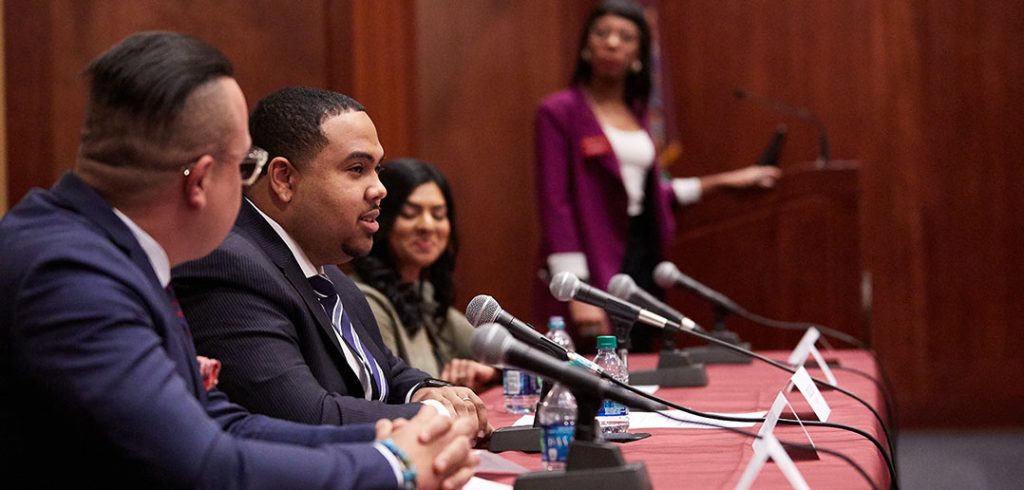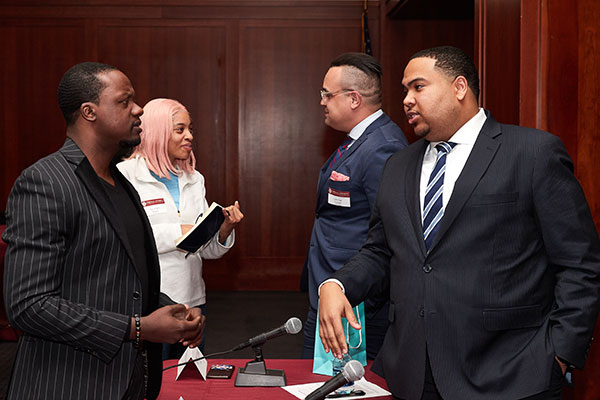This complex topic was the subject of a candid and lively panel discussion at a recent Fordham Alumni Career Workshop titled “How to Succeed as a Diverse Candidate.”
Fordham MBA candidate Bliss Griffin moderated the event, which featured alumni working in finance, communications, health care, and software engineering. Griffin, a former actor and a trainer for diversity and inclusion programs, laid the groundwork for the discussion by noting that diversity is “absolutely more than things that are visible,” and it can include everything from age, race, and gender to educational or geographical background.
One major takeaway was a piece of advice from Karthy Bhatt, GABELLI ’18, a product manager at clinical lab company Quest Diagnostics: “Get comfortable with the uncomfortable,” she told several dozen Fordham students and recent graduates in the audience. Conversations about diversity can be tough, but they’re necessary.

Know Your Self-Worth
Bhatt and others touched on some of the disagreeable situations that can arise when you’re the only employee of your race, gender, sexual orientation, or age group at your job. These ranged from racist comments made about minority family members to insensitive remarks about accents.
“Sometimes [turning those uncomfortable situations around is] not as easy as having a conversation, and sometimes it is,” Bhatt said. “So I do find them happening in the workplace, but I think for myself, having that self-awareness and the emotional intelligence to handle those situations helps. I know myself, I know my self-worth, and I know what I bring to the table. And when you show people that piece of you, it does start to change mindsets, but it’s not easy.”
And at times, change can seem far off or slow in coming. Until workplaces themselves start to look more varied, diverse employees can find themselves living in a duality—code-switching or being a slightly different version of themselves depending on the context, said Brandon Stanford, GABELLI ’18.
“Your duty is to [extend] your hand down and bring [other diverse] people up because there are not enough of us here,” he said. “That’s the only way you get this political capital that will be a way to move the needle.”
Finding Mentors and Affinity Groups
When it comes to advancing in your career, all the panelists were largely in agreement: It’s your connections with others—whether they are mentors or peers—that will help you move forward.
“It’s all about networking,” Stanford said. “You have to talk to people; there is no way around that.”
In Stanford’s case, he forged new links via LinkedIn with those whose careers he admired. One of those connections ultimately led to his current position as a senior consultant at Ernst & Young—a departure from his previous career in education where he worked his way up to director of operations for a charter school network.
Mentors can also provide advice and guidance as you navigate your career trajectory, which is key for advancement, said Bhatt. She has prioritized making sure those advisers offer a variety of perspectives, too.
“I think there is so much value in mentorship,” Bhatt said. “I took it upon myself to reach out and find those mentors at my workplace and outside of my workplace. … I was very purposeful about picking my mentors and making sure that that group was diverse as well. So my mentors range [and include] different races, women and men, different age groups. It also should be someone that you not only aspire to be, but you aspire to emulate their characteristics.”
Affinity groups at a workplace—those focused on gender, race, sexuality, or other commonalities—can also provide excellent support networks to diverse candidates, the panelists said. And if your workplace doesn’t have one? You can always take charge and create one either at your job or elsewhere. Panelist Victor Luciano, PCS ’02, vice president of sales at Spanish-language TV network Azteca América, did just that at Fordham. He currently chairs MOSAIC, the alumni affinity chapter that looks to support diversity and inclusion in the Fordham community.
Jemina Molines, a Fordham sophomore and the vice president of the Black Students Alliance at the Lincoln Center campus, said she was inspired by the panelists and their stories.
“I think these events are a system of support for students, and it helps us to know that there are [people]like us that have gone through difficult things but have been able to get past that and go on to their respective fields and be successful,” Molines said.
Bottom line: starting conversations on diversity can pave the way for changing the images of what accomplishments look like—and who can achieve them.
Lorelle Reid, FCRH ’14, who transitioned from a career as a model to a software engineer, summed it up this way in her advice to attendees: “You don’t have to look a certain way to succeed in a certain way.”
—Kelsey Butler, FCLC ’10


